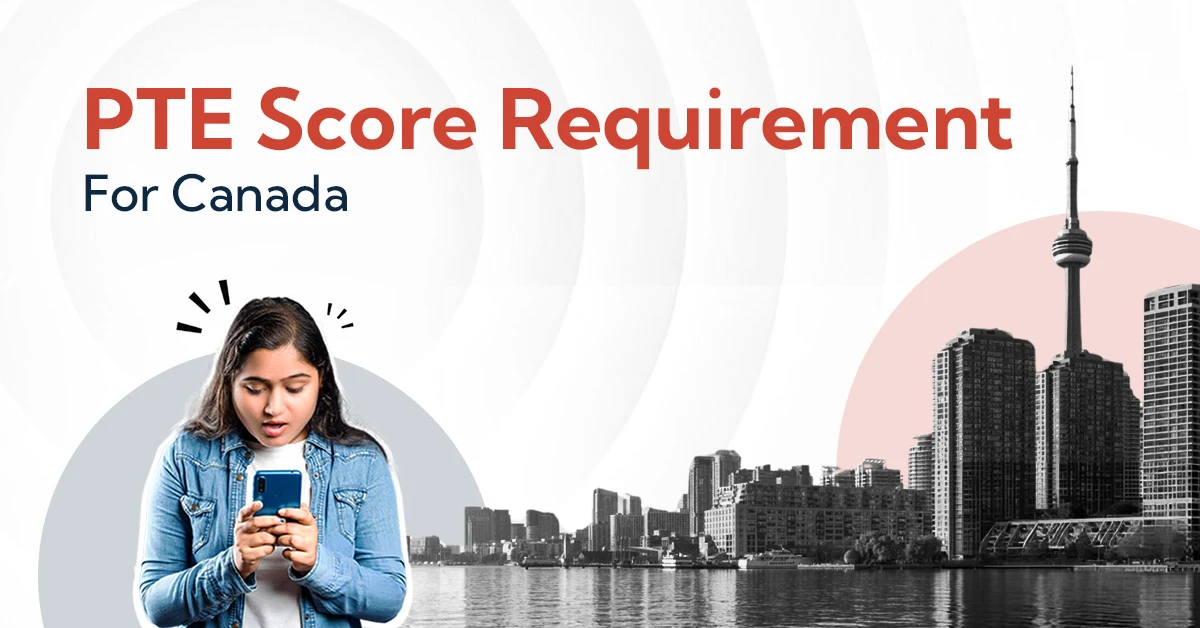Planning to study in Maple Leaf Country, Canada? You’re embarking on a journey that can open doors to exceptional educational opportunities and, potentially, a bright future in this diverse and welcoming nation. To make this dream a reality, you’ll need to clear certain requirements, one of which is achieving a specific Canada PTE score requirements. In this comprehensive guide, we’ll explore PTE score for Canada, and we’ll offer some valuable insights to help you on your way. So, let’s dive in!
How much PTE score is required for Canada?
To study in Canada, you must meet specific Canada PTE score requirements. These requirements can vary depending on your level of study, whether it’s for a bachelor’s degree, a master’s degree, or a diploma program. To make this information more accessible, let’s break it down into a table for quick reference:
| Study Level | Minimum PTE score for Canada |
| Diploma | 45 Overall (Min. 36 in each module) |
| Undergraduate | 50 Overall (Min 45 in each module) |
| Post-graduate | 65 Overall (Min 50 in each module) |
List of Canadian colleges accepting PTE score
Let’s explore top Canadian colleges and PTE scores they accept. Here’s a comprehensive list of Canada PTE score requirement for your reference:
| College Name | Minimum PTE score for Canada |
| Centennial College | 60+ Score (for UG and PG) |
| Seneca College | 58+ (certificates and Diploma); 60+ (Degree) |
| George Brown College | 54,50 in each section (certificates and Diploma); 60,55 in each section (Degree) |
| Humber College | 53 – 57 (certificates and Diploma); 58 – 60 (Degree); 61-64 (Graduate Certificates) |
| Georgian College | 58 (certificates and Diploma); 61 (Degree and Graduate Certificates) |
| Niagara College | 60,50 in each section |
| Douglas College | Minimum overall score of 56 |
| Durham College | 53,49 in each section (certificates and Diploma); 60,57 in each section (Degree and Graduate Certificates) |
| Algonquin College | 53,45 in each section (certificates and Diploma); 60,53 in each section (Degree and Graduate Certificates) |
| Alexander College | 50+ overall, > 50 in writing |
List of Canadian Universities accepting PTE score
If you’re considering Canada for your academic journey and wondering which universities accept PTE scores, we can help. Here’s a comprehensive list of Canadian universities and the PTE scores they accept:
| University Name | Minimum PTE score for Canada |
| University of British Columbia | 54 Overall: 50 minimum in each section |
| University of Alberta | 62 Overall: 60 minimum in each section |
| McMaster University | 60 overall with minimum score of 60 in Writing and Speaking |
| University of Waterloo | 63 overall, 65 writing, 65 speaking |
| University of Ottawa | 60 (overall score) with 60 in Writing |
| Queen’s University | Overall 60 |
| York University | Minimum 60 (UG); Minimum 76 (PG) |
| Concordia University | Minimum overall PTE academic score of 61 with a minimum of 46 in speaking and writing |
| University of Guelph | Overall 60 and a minimum score of 60 in each section. |
| University of Manitoba | Minimum score required: 58 |
Ready to Begin Your Canadian Academic Journey? Transglobal Overseas can assist you throughout the application process. Our experienced team will ensure that you meet all the requirements. Get in touch with us today!
What is the minimum PTE score for Canada student visa?
Your PTE score is a key factor that reflects your English language proficiency, and it plays a crucial role in the student visa application process. It’s worth noting that the Canada PTE score requirement is subject to change, and specific institutions or programs may have slightly different criteria.
However, the minimum PTE score required falls within the range of 58 to 73. To ensure a smooth visa application process, it’s essential to meet the PTE score requirement for Canada study visa.
Navigating the various requirements for a Canada student visa, including PTE scores, can be complex. But you don’t have to go through it alone. Transglobal Overseas, with its expertise and experience, can guide you throughout the process, offering valuable visa guidance for a seamless journey.
PTE Overview
| Feature | Description |
| Test duration | Approximately 2 hours |
| Test format | 20 different question types across the 4 skills |
| Score range | 10-90 points on the Global Scale of English |
| Scoring system | Computer-marked for Speaking and Writing; human raters for Reading and Listening. |
| Delivery method | Computer-based at designated test centers |
| Score report delivery | Within 48 hours of test date |
| Score validity | 2 years |
| Benefits | Fast results, flexible test dates, detailed score report, recognized by many universities and institutions |
| Drawbacks | Computer-based format may not suit all test-takers, not accepted by all institutions |
Frequently Asked Questions
1. How much pte score required for canada after 12th?
Minimum PTE score for Canada after the 12th:
- Diploma courses: Minimum score range is 50-55.
- Undergraduate courses: Minimum score range is 50-60.
2. What PTE score is required for Canada after Graduation?
Minimum PTE score for Canada:
- Diploma: 45 overall with a minimum of 36 in each section.
- Postgraduate: 65 overall with a minimum of 50 in each section.
However, these are just minimums! Most universities expect higher scores:
- Postgraduate: Usually in the range of 61-64, with top programs often demanding 65-70 or higher.
3. How to Deal With Not Getting Your Desired PTE Score?
Here are some steps you can take to deal with the setback and strategize for future success:
- Analyze Your Score Report: Identify areas where you struggled the most and where you performed well.
- Once you know your weak areas, create a focused study plan.
4. Is PTE Accepted in Canada?
Yes, the Pearson Test of English (PTE) is accepted in Canada for both study purposes and work and migration, including permanent residency.
5. Which universities accept PTE 50 score in Canada?
Some Universities in Canada that accept a PTE score of 50:
- Dalhousie University (certain programs)
- McMaster University (certain programs)
- Western University (certain programs)
- York University (certain programs)
- University of Saskatchewan (certain programs)
It’s crucial to check the specific PTE score requirements for the universities and programs you’re interested in. You can find this information on the university’s website or by contacting our study abroad consultants in tilak nagar, Delhi.
6. Which countries are accepting PTE?
Here’s a list of some of the countries that accept PTE scores:
- North America: United States, Canada
- Europe: United Kingdom, Ireland, Austria, Belgium, Denmark, Finland, France, Germany, Greece, Iceland, Italy, Luxembourg, Netherlands, Norway, Portugal, Slovenia, Spain, Sweden, Switzerland
- Asia: Australia, New Zealand, Malaysia, Singapore, Japan, India, Philippines, Thailand, Vietnam
- Middle East: Bahrain, Cyprus, Iran, Iraq, Israel, Jordan, Lebanon, Oman, Saudi Arabia, Turkey, United Arab Emirates
7. Is PTE 57 score good?
Whether a PTE score of 57 is “good” depends on what you are using it for:
- University admissions: Some universities, particularly those with lower entry requirements, might accept a score of 57. However, most competitive universities would ask for a higher score.
- Visa applications: For certain visa categories, a score of 57 might be sufficient. However, it’s crucial to check the specific requirements for your targeted visa category.
- Professional purposes: Depending on the field and role, a score of 57 might be enough for basic communication. However, for positions requiring strong English proficiency, a higher score would be more advantageous.
However, 65-75 is generally considered a “good” PTE score, as it opens doors to top universities and demonstrates an ability to follow academic-level instruction.
8. What is the success rate of PTE in Canada?
- PTE and student visas: While Canada doesn’t track specific success rates based on test types, over 90% of Canadian universities accept PTE scores. If you meet the university’s PTE requirement and other visa criteria, your chances are generally high.
- PTE and immigration: Canada uses the Canadian Language Benchmark (CLB) for immigration, not directly PTE scores. You can achieve the required CLB 7 (equivalent to PTE 65-72%) by scoring well on PTE. However, success in immigration depends on your total application profile, not just the language test.
9. What is the required PTE score for Canada in 2025?
In 2025, a minimum PTE score of 58-65 is generally considered acceptable for most universities and colleges in Canada.
10. What is the PTE score requirement for undergraduate and postgraduate courses in Canada?
A general PTE score of 58-65 is often considered acceptable for undergraduate programs, while 65-73 is common for graduate programs.
11. What is the validity period of a PTE score for Canada?
PTE Academic scores are valid for two years from the date you took the test, both for immigration and academic purposes.
12. Is PTE easier than IELTS for studying in Canada?
Whether PTE or IELTS is “easier” for studying in Canada depends on individual strengths and preferences, as both tests assess the same language skills, but PTE is computer-based with AI scoring, while IELTS is more traditional with human examiners.
13. What are the alternative English proficiency tests accepted in Canada?
For Canadian immigration and study purposes, approved English proficiency tests include CELPIP, PTE Core, TOEFL, Duolingo English Test, and CAE
14. Are there any changes in the PTE requirements for Canada in 2025?
In 2025, there are no major changes in the PTE score requirements themselves, but it’s crucial to check specific program and institution requirements, as they vary
15. How to prepare for the PTE exam for Canadian university admission?
Prepare for the PTE exam by understanding the test format, practicing all four sections (Speaking, Writing, Reading, and Listening), and using official PTE study materials. Take mock tests, improve time management, and focus on grammar, vocabulary, and pronunciation for higher scores.
16. How is the PTE score calculated?
The PTE score is calculated by averaging scores from four communicative skills (Listening, Reading, Speaking, Writing) and a fifth component representing the average of enabling skills.




